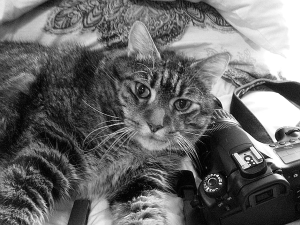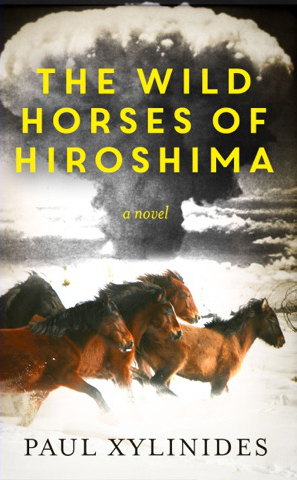Kurt Brindley's Blog, page 117
December 21, 2014
Take Me To Church
Filed under: Photography Tagged: architecture, buildings, cathedrals, churches, gothic, gothic buildings, graphic art, graphic design, photography, Washington National Cathedral

December 20, 2014
decent dissent decent descent
Hercules Gone Mad – Part One
Rebels for Love
Read an Excerpt
Filed under: Books, Photography Tagged: books, dystopia, dystopian literature, fiction, graphic art, graphic design, Hercules Gone Mad, Heroes of Dystopia, novel series, novels, photography, sagas, writing

December 19, 2014
THE WILD HORSES OF HIROSHIMA – The Big Reveal!
In my view, it’s always pretty awesome around here, especially since we kicked off the Indie Author Book Selection & Review and Relating to Humans features a while back. But this week has been especially awesome. For this week we have witnessed the original thinking, compelling insight, and unique writing style of Indie Author Paul Xylinides with his essays TOTAL WAR OR TOTAL PEACE, a Relating to Humans Political Issues contribution, and Covered in Fish Oil and Honey while Sitting in a Public Toilet, his Guest Author contribution.
And it’s quite obvious to me, and empirically so, that you all think Paul’s essays are pretty awesome, too, judging by all the “Likes” you’ve given them, and the interesting comments you’ve left in response, and, especially, by all the page views they’ve received.
I must say, I wholeheartedly concur with your assessment.
Now, admittedly, I have an occasional tendency toward hyperbole, but you can take me at my word that, after reading Paul’s interesting essays, I was very excited to receive his book THE WILD HORSES OF HIROSHIMA, the IABS&R Volume 2 selection.
And so, it is with great pleasure that I present and proudly reveal to you Paul’s donation to me, his book THE WILD HORSES OF HIROSHIMA.

At the Post Office; or, more dramatically, at The Drop
This postal worker asked not to be identified with any suspicious packages from Canada. Actually, she gave me permission to take her picture; however, I did such a lousy job of it I don’t think she would be pleased with the result.
The Goods

Front cover
The first thing I noticed about the book was the way it felt. It is, or at least appears to be, a very high quality production, with a slight moleskin notebook feel to it. It’s a rather pleasing experience I must say.
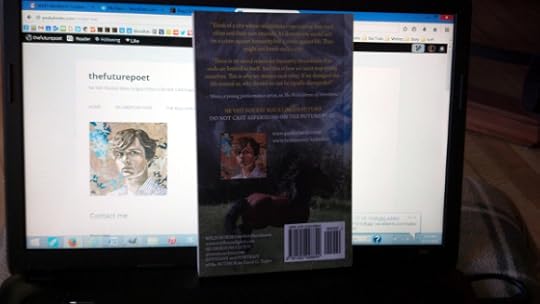
Back cover
This picture is a little dark so it might be hard to tell; however, the images on the cover, front and back, are sharp and clear and all the coloring works well together. Proper image credit, etcetera, is given where credit is due.
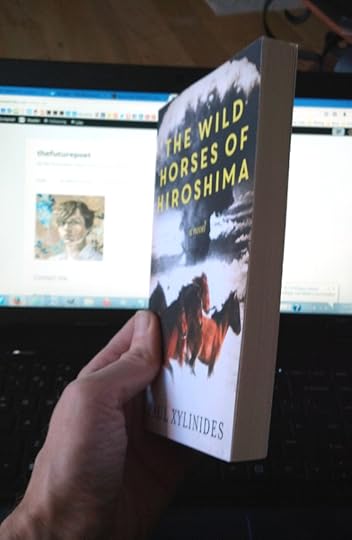
Look at all those pages…with page numbers!
Seeing how it seems Canada is always trying to play itself off as European in general and French in particular, I was worried that this book would follow the same trend at our IABS&R Volume 1 selection, hailing from the United Kingdom, and come without page numbers. But thankfully Paul’s book follows tradition and all its wonderful practicality and includes page numbers.
Just kidding of course…well about everything but the page numbers. I am thankful for the page numbers.
Spine
As you can see, it is a pretty good looking book and I truly look forward to the read.
Though, I have a feeling it won’t be an easy read, seeing how Paul is evidently, as proven by his essays, a rather smart dude who likes to write in long and involved sentences. But to me that is a good thing…or it could, and should, be a good thing. I liked to be challenged as a reader. I like to have to work for my reward.
Let’s just hope I am rewarded for my effort.
Off to work I go.
Wish me luck…
Filed under: Books Tagged: authors, book covers, book reviews, books, Canada, fiction, IABS&R Volume 2, Indie Authors, literature, Paul Xylinides, The Wild Horses of Hiroshima, writing

ちょっと内緒話。。。
And all this time I thought Jack Kerouac only had an affinity for the lovely and loving Megi of HappyNest in America, sleeping, and food.
Come to find out, he also has an affinity for the camera.
Or, to him, is it merely a pillow…
 Originally posted on :
Originally posted on :
愛用のカメラをそばにおいて眠るのが習慣の私がこよなく愛する猫のケロアックは、カメラをまくらに寝るのが大好き。。。
* * *
にほんブログ村 アメリカ情報でも、更新記事をお届けしています。
Filed under: Photography, Uncategorized Tagged: animals, Black and White photography, cameras, cats, HappyNest in America, Japan, Japanese language, pets, photography, The Lovely & Loving Megi

Nebula Cultus no. 2
Filed under: Photography Tagged: clouds, cults, cultus, graphic art, graphic design, landscapes, nature, nebula, photography, sunsets, trees

December 18, 2014
Sorry
Sorry ’bout the homework.
Sorry ’bout the room.
Sorry ’bout the mix up
With the chimney and the broom.
Sorry ’bout the hamster.
Sorry ’bout the bug.
Sorry ’bout the purple stain
In the middle of the rug.
Sorry ’bout the superglue.
Sorry ’bout the report card.
Sorry ’bout the neighbor’s cat
I buried in the yard.
Mom, I really am so sorry
For not behavin’ like I should.
And if you please just give me one more chance
I promise I’ll be good.
Oh yeah…sorry ’bout the china.
From Poem Man
Filed under: Poetry Tagged: apologies, art, artwork, behavior, children, children's poetry, discipline, drawing, Poem Man, poetry, rhymes, rhyming poetry, second chances, writing

Look at it this way…
What you are now looking at represents more than just a blog post.
What you are really seeing is a stage…
And these words are my performance.
Filed under: Art Tagged: acting, art, masks, performance art, philosophy, Sophocles, stage, theater, writing

December 17, 2014
Guest Contributor: Paul Xylinides, Author of THE WILD HORSES OF HIROSHIMA
Covered in Fish Oil and Honey while Sitting in a Public Toilet
by Paul Xylinides
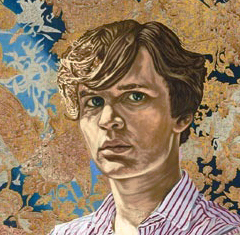
Paul Xylinides
At one time, I might have listened to my puritanical side and questioned this title for a post and perhaps especially a post that I had been invited to contribute as unnecessarily sensationalistic in the same manner that I once dismissed the real life event of performance art to which it refers. In fact when I began to write the novel whose working title The Sumo and his Bird finally became The Wild Horses of Hiroshima one of my intentions was to undertake a full-scale critical denunciation of events similar to what is described and commonly tagged by the rubric of “performance art”. I intended at the same time to include in the sweep of my scathing criticism much of the “installation art” that I had long dismissed as either insulting or derivative. These attitudes of mine reach far back to the original instigator of this type of art presentation – the one who contributed to the world’s cultural understanding with the galley exhibit of a men’s urinal. The following is the Tate Gallery’s description of the object and something of Marcel Duchamp’s idea of its artistic utility:Fountain is one of Duchamp’s most famous works and is widely seen as an icon of twentieth-century art. The original, which is now lost, consisted of a standard urinal, laid flat on its back rather than upright in its usual position, and signed ‘R. Mutt 1917′. The Tate’s work is a 1964 replica … Fountain is an example of what Duchamp called a ‘readymade’, an ordinary manufactured object designated by the artist as a work of art. It epitomises the assault on convention and good taste for which he and the Dada movement are best known.
Since this provocative exhibit, any number of so-called artists have followed suit – apparently forgetful of the dictum that creative expression is nothing if not original. Today, nearly one hundred years later, one can find in the Catalogue of Montreal’s Musée Des Beaux Arts’ permanent collection an installation piece that comprises a janitor’s pristine cleaning supplies: detergent, bucket, mop, etcetera. I like to think the artist and the gallery mean it to signify a final cleaning up of what has been paraded as art in the same spirit as Duchamp’s offering and with little more to say, but I suspect that the powers that be would correct me while looking severely down their noses. To my mind, this type of work, in fact, has always represented an abdication of the artist’s responsibility to present a meaningful vision of the world and his/her times – one that advances and adds to a society’s and to an individual’s sensibility. I often feel that one can attribute much of this abdication to the horrors that the past century visited upon humankind. It is perhaps telling that Duchamp’s contribution came towards the end of the 1st World War. The nihilistic despair that followed upon the 2nd World War as to the possibility of any meaningful artistic expression is well-known and informed much of the career of the British painter Francis Bacon whose paintings recently broke all records in the sale of a work of art. Whether or not his prolific output had any meaning whatsoever – he claimed it had not – what, not to put too fine a point on it, incensed me in so much of what postured as art of Duchamp’s order is the patent cynicism of riding on the coat-tails of a relatively facile act that happened to be original and shocking for its time but whose originality ended there and whose shock value degenerated into cynical, juvenile and at times literally excremental productions. Less offensive from an olfactory perspective would be the choice on the part of some recent artists to exhibit the insides of a couch that they obtained on Craigslist.
The performance piece of the Chinese artist Zhang Huan where he covered himself in fish oil and honey and sat for an extended period in a public latrine especially remained with me after I read about it in an old edition of TIME magazine where I discovered that this particular artist had so enthralled a prominent New York art critic that the man pilgrimaged to the Far East. On meeting Huan, he promptly fell to his knees and kissed his hand. The type of work that the critic so venerated coupled with the 1998 exhibit of an artist’s bed – a work that “consists of dirty sheets, underpants stained by menses, used condoms, empty liquour bottles, and pregnancy tests” cemented my feelings against an art form that seemed to be no more than a symptom of a spiritually and creatively bankrupt age. Had the artist reproduced said scene on canvas rather than have the so-called cognoscenti promote and utilize future curatorial resources for the preservation of the wretched compilation of her personal domestic drama, my response would have been quite different. In another art form – musical composition and performance, the sight of John Cage sitting at his piano and not playing leaves one to feel that it is only writers who cannot avoid the very real and difficult task of giving life to their creative urges in the medium they have at hand.
When I was searching for a theme for the novel with its working title The Sumo and his Bird, in my usual manner, I had a single image that intrigued me and that I wished to be the starting point for some particular view of the world that seemed best to fit it. The image was of a sumo wrestler attended by his pet bird – hardly sufficient material for a full-scale narrative but Japanese society has always struck me as appealingly aesthetic in its conduct of daily social life and here was an opportunity to immerse myself in it if only in my imagination. – I am not so naive as not to understand that an actual visit to the country might very well completely disillusion me, but in the end I am not writing about a place but producing a work that uses my view of the world as its material. – However I still desperately needed a narrative line. In a previous novel, An American Pope, that had begun in the same tentative manner, I eventually found my dramatic foil in the Catholic Church, enabling me to explore my ideas on Christianity and how the original teachings had become warped over time. I thought to employ the same methodology in The Sumo and his Bird and, in the intimidating person of a sumo wrestler, take on the dispiriting assumptions – as I viewed them – of what had become the art world’s establishment. It was at this point that the thought did come to me that I should be absolutely sure that I understood exactly what it was that I was attacking. In other words, some due diligence was in order. What I discovered caused the entire enterprise to flip on its head and me to adopt an entirely different course.
It appeared that Zhang Huan’s intention had, contrary to my uninformed reading of it, been to confront the Chinese government with the murderous implications of its one-child policy that led to the infanticide of hundreds of thousands of female babies by parents who wished for a male offspring. His statement to the powers that be was – quoting from memory, “here am I willing to nourish the humblest of creatures – the flies that settle on my fish oil and honey smeared flesh – while you allow the deaths of the nation’s innocent children.” This was hardly the act of shallow sensationalism that I had thought it to be and it provoked a turning point in my own thinking. Although there continue to be artists derivatively – to my mind – covering themselves in honey or chocolate and others exhibiting this found object or that with the satisfaction of a modern Michelangelo, Zhang Huan had duly chastised and inspired me. Having located my sumo wrestler in Hiroshima, I turned my attention to a challenge of universal relevance – to an ongoing existential threat that we all face. According to the January 9, 2012 edition of TIME magazine, “With current stockpiles [of nuclear weaponry], you could come close to wiping out humanity.” How a Zhang Huan might respond and what might be the contribution of a sumo wrestler whom I now envisaged as half-American and half-Japanese became the ultimate focus for my novel that would eventually find its title: The Wild Horses of Hiroshima.
Let me end with my own personal aesthetic dictum as far as it goes: art isn’t raw material, it’s what you do with raw material. Murasaki Shikibu who wrote the first novel in literary history – The Tale of Genji – stated that she was compelled to preserve the “fascinating” society of her time for the benefit of future generations. In many ways ours has been an appalling society where the challenge for its artists is very much greater.
The Wild Horses of Hiroshima was the selected novel for the IABS&R Volume 2
Filed under: Literary Tagged: art, authors, books, Guest Contributors, Hiroshima, IABS&R Volume 2, Indie Authors, Japan, Marcel Duchamp, Murasaki Shikibu, Paul Xylinides, The Wild Horses of Hiroshima, writing, Zhang Huan

Fenc’d no. 2
Filed under: Photography Tagged: farm animals, farms, fences, fields, fog, forest, grass, hills, metaphors, nature, nature photography, photography, rolling hills

December 16, 2014
TOTAL WAR OR TOTAL PEACE – A Relating to Humans Political Issues Feature
I do not have much to say as an introduction to this powerful topical essay by Paul Xylinides, our IABS&R Volume 2 selectee, other than to compel you to go take a look at today’s headlines. There you will unfortunately witness once more what brutality we humans are willing to inflict upon other humans in an effort to further our own goals, be they political, religious, or whatever cause it may be that motivates us into a frenzy of fanaticism and murderous hate.
My prayers are with Pakistan as I mourn the lost lives of all the innocent children.
Paul will also be contributing a guest post for us tomorrow.
– 8:00pm (EST), Wednesday, December 17, 2014
TOTAL WAR OR TOTAL PEACE
by Paul Xylinides
The concept of total war has been especially widespread in execution in the twentieth century. It means just what it says, that is, the decision by one or both sides in a conflict to use all and every means in order to prevail. War crimes become unavoidable and are a matter of course under these scenarios. Moral and legal concerns are completely set aside. Intended to prevent or, at best, minimize carnage directed towards the innocent, the rules of war are effective only so long as one side enjoys vastly superior capacities and thus the luxury of choosing how to conduct itself in an engagement. Recent comments by Vladimir Putin as to his country’s continued possession of a nuclear arsenal illustrate what recourse a threatened nation feels justified to employ. Today, the United States is able to act militarily within the rules of war. Should the day come that a figure such as the present Russian leader were to carry out his veiled threat, it is not conceivable that the United States would not respond in kind.
The Isis fighters presently operating in the Middle East are employing tactics of total war that would be familiar to any student of military history. It is pointless to be self-righteous in one’s condemnation as long as one possesses the means and is willing in certain circumstances to employ the exact same strategy. When the United States dropped the bomb on Hiroshima and then on Nagasaki, the rules of war were set aside, the innocents sacrificed. Similar events have occurred throughout history although by different means. The Germans employed these tactics as did the British who fire-bombed Dresden. Cities and their populations have been razed. In the distant past, Hannibal levelled Carthage, annihilated its entire populace and returned it to desert. Today he enjoys the status of a heroic figure crossing the wintry Alps with his elephants. Al-Asaad’s father, the former Syrian dictator, put down a rebellion and subsequently massacred all the families of the rebels. He had them buried beneath a parking lot. For his people, he too is a hero. The Soviets and the Chinese are infamous for what they unleashed upon their own citizens. What has been inflicted upon native peoples everywhere is a shame of international proportions. All sides feel justified in what they do no matter how “evil” when they see the opposing side having done the same. Today’s torture debate where the United States’ traditional means of responding to an enemy appeared insufficient fits exactly into these scenarios.
Humanity has produced a climate of violence that extends throughout history and in this climate lightning and thunder penetrate deep into anyone who feels wronged or threatened. At the street level, individuals avail themselves of as much weaponry as possible and embark on killing sprees. Paranoia sets in. Police officers and citizens are the tragic victims. The powers that be conduct themselves no differently and set the example. They continue to threaten the entire planet with annihilation as long as they insist upon a nuclear option for their perceived or postulated “interests”. The logical conclusion of man’s history of armed conflict is that the weak will turn to whatever means they have at hand and the strong will resort to them if they must. No power can expect a lesser opponent to abide by the so-called rules of war. Warring parties have the most lethal instruments possible at their disposal and all sides whatever the conflict are willing to use them should the excuse be there.
Every single action of armed conflict is a denial of another’s right to exist or an assertion of one’s right to supremacy. The question arises and has, in fact, always been there as to what is humanity’s purpose. If it is solely to gain ascendancy over others or solely to gain its own ends in disregard of everything else, then it is little wonder that today it finds itself and the planet under constant threat. It may be that respect not only for our fellow man but also for the world itself with all of its life forms is required in order to avert a complete and total tragedy. Does not a true greatness of soul extend beyond the works of man – his art, his scientific discoveries – to a connection with the whole of life?
The biblical story of Genesis begins with an injunction for man to “subdue” the earth and to have “dominion” over it. The further admonition is to “replenish” the earth. It seems we’ve gotten the subduing and dominion half of it down pat, but tragically, we’ve neglected the replenishing part both of the earth and of ourselves. Man being the creature of infinite possibilities that he is, such a transcendent undertaking should eventually find partners and give pause to those who continue to be inflamed. Mankind has always entertained an Edenic vision. It is a vision of total peace.
Tolstoy, in his great novel WAR AND PEACE, postulates that history results from an accumulation of individual decisions. Ordinary citizens determined of their own accord to leave their day to day lives and join Napoleon’s armies. Without them, there would not have been the Napoleon of history. Tolstoy entertained this view of individual responsibility in czarist Russia. How much more obvious must it be today in our democracies? Each one of us decides the life that we want and the world in which to live. Wars come to an end when individuals say no. The American people ended the Vietnam war not their government.
When Voltaire’s eponymous hero Candide returns home disillusioned with the world of man, he determines that the best he can do in the wicked world that he finds himself is to take care of his own little garden. At least here he can make and be the difference and realize the good in himself. A multitude of Candides – disillusioned with wars and counter-wars and respectful of more than their own human-centric interests – may be what is needed in order to replenish the world in which we all have a part.
Filed under: Politics Tagged: authors, Candide, Indie Authors, ISIS, peace, Political Issues, politics, Relating to Humans, religion, Tolstoy, Voltaire, war, War and Peace, writing







